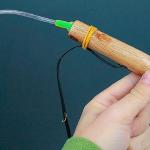No matter how high-quality the toilet bowl and fittings are, problems arise from time to time: either water is not collected, or vice versa, it constantly flows from the drain. All these problems are associated with fittings (drain and inlet valves), which are placed in the drain tank. Next, we’ll talk about how to install it, change, adjust and repair it yourself, with your own hands.
Internal organization
The toilet cistern consists of two simple systems: a set of water and its discharge. To troubleshoot possible problems, you need to understand how everything works and works. First, consider what parts the old-style toilet bowl consists of. Their system is more understandable and visual, and the operation of more modern devices will be clear by analogy.
The internal fittings of a tank of this type are very simple. The water supply system is an inlet valve with a float mechanism. The drain system is a lever and a pear with a drain valve inside. There is also an overflow pipe - through it excess water leaves the tank, bypassing the drain hole.

The main thing in this design is the correct operation of the water supply system. A more detailed diagram of its device is in the figure below. The inlet valve is connected to the float using a curved lever. This lever presses on the piston, which opens / closes the water supply.
When filling the tank, the float is in the lower position. Its lever does not put pressure on the piston and it is squeezed out by water pressure, opening the outlet to the pipe. Water is gradually drawn in. As the water level rises, the float rises. Gradually, he presses the piston, blocking the water supply.

The system is simple and effective, the filling level of the tank can be changed by bending the lever a little. The disadvantage of this system is a noticeable noise when filling.
Now let's look at how the drain of water in the tank works. In the variant shown in the figure above, the drain hole is blocked by a bleed valve pear. A chain is attached to the pear, which is connected to the drain lever. We press the lever, lift the pear, the water drains into the hole. When the level drops, the float goes down, opening the water supply. This is how this type of cistern works.
Modern models with lever drain
They make less noise when filling the cistern for toilet bowls with a lower water supply. This is a more modern version of the device described above. Here the tap / inlet valve is hidden inside the tank - in a tube (in the photo - a gray tube to which the float is connected).

Drain tank with water supply from below
The mechanism of operation is the same - the float is lowered - the valve is open, water flows. The tank was filled, the float rose, the valve turned off the water. The drain system remained almost unchanged in this version. The same valve that rises when you press the lever. The water overflow system has not changed much either. This is also a tube, but it is brought out into the same drain.
You can clearly see the operation of the drain tank of such a system in the video.
With button
Models of toilet bowls with a button have similar water inlet fittings (there are with a side water supply, there are with a bottom one). Their drain fittings are of a different type.

The system shown in the photo is most often found in toilet bowls of domestic production. It is inexpensive and reliable. The device of imported units is different. They basically have a bottom water supply and another drain-overflow device (pictured below).

There are different types of systems:
- with one button
- water drains as long as the button is pressed;
- draining starts when pressed, stops when pressed again;
- with two buttons that release different amounts of water.
The mechanism of work here is slightly different, although the principle remains the same. In this fitting, when you press the button, a glass rises, blocking the drain. The stand remains stationary. In short, this is the difference. The drain is adjusted using a swivel nut or a special lever.
Installation and replacement of cistern fittings
A significant part of toilet problems are solved by adjusting or replacing the cistern fittings. In any case, you need to know how to disassemble and assemble the inside of the tank. This skill will definitely help you. When replacing, you must first dismantle the old device, and then install a new one. We will describe in detail the whole process, including the installation of new fittings.
How to remove the lid from the tank
If a drain tank with a button is being repaired, it is not always immediately clear how to remove the lid. This is easy to do: press the button, turn the ring.

If it doesn’t work with your fingers, pressing the button, consider its inner rim. There are two special slots. You can take a screwdriver with a narrow end, turn the ring a little with it. Then you can already twist it with your fingers.
After that, remove the button by pulling it up. Everything, the lid can be lifted.
Tank dismantling
To replace the old fittings of the flush tank, it must be removed from the toilet bowl. First of all, turn off the water supply, then drain the water from the tank. Then, using the keys, remove the water supply hose (it is attached to the side or bottom).

Next, you need to disconnect the tank from the toilet bowl. If you look under it from below, you can see the bolts that are tightened with nuts. So we unscrew them using a set of open-end wrenches or an adjustable wrench. Before that, place a container near the toilet or lay a rag - a certain amount of water always remains in the tank, when the nuts are unscrewed, it will drain.
Having unscrewed two nuts - on the right and on the left, we remove the tank. There is usually a gasket on the bowl. If it is deformed or dried out, it is also desirable to replace it.

The tank is placed on a flat surface. There is a large plastic nut at the bottom of it. It holds the drain mechanism, we unscrew it. Sometimes the first turns have to be done with an adjustable wrench, but do not overtighten it - the plastic can be brittle.

Now the water drain mechanism can be easily removed.

We remove the water supply mechanism in the same way. With bottom feed, the fastening nut is also at the bottom (right or left of center).


After that, we look inside the drain tank. Usually, rusty sediment, small metal particles, sand, etc. accumulate at the bottom. All this must be removed, if possible, washed. The inside must be clean - trash that has fallen under the gaskets can cause a leak. After that, we begin the installation of new fittings.
Installation of drain tank fittings
Everything happens in reverse order. First, we install a new rack of the drain mechanism. We unscrew the plastic nut from it, put a rubber gasket on the pipe. It can be white (as pictured) or black.

We start the device inside the container, from the outside we wind the plastic nut. We twist it, as long as possible, with our fingers, then tighten it a little with a key. You can not overtighten - it will burst.

Sealing
Now on the toilet bowl we replace the o-ring sealing its connection with the drain tank. Dirt and rust often accumulate in this place - we wipe it first, the seat must be dry and clean.

Inside the tank we install the fixing bolts, not forgetting to put the gaskets. We put the drain tank in place until it can be leveled. The main thing is to get the screws and the outlet part into the seats. We take a washer, a nut and screw them onto the screws.

When both nuts are installed, but not yet tightened, we level the container. Then, using the key, we begin to tighten the mount. We twist a few turns, then to the right, then to the left.
Installing the exhaust valve
Lastly, install the inlet valve for the drain tank. It could have been installed earlier, but then it is inconvenient to install the mounting bolts - there is too little space. We also put a gasket on the outlet pipe, then install it inside, fix it with a nut.

The next step is to connect water to the same pipe. Before connecting the flexible hose for water, we open the water for a while, making it possible to remove the scale that accumulates every time after closing the tap, even for a short time. Having lowered a certain amount of water (substitute a bucket so as not to wet the floor), we connect the hose to the fitting (we turn off the water again).

Although the fitting is metal, it is also not necessary to tighten this connection strongly - first with your fingers, then one turn with a key. If drops are found when the water is turned on, you can tighten it another half turn. After that, we check if the system works correctly. If everything is correct, install the cover, fasten the button. You can test again. This completes the installation of the fittings of the drain tank. As you can see, everything can be done by hand.
Adjustment and repair
During the operation of the toilet, problems periodically arise - either it flows, or, on the contrary, no water is drawn into it. Sometimes, tired of the inconvenience, people buy new toilets. But in vain. Most of the faults are fixed in 10-20 minutes. Moreover, everything is so simple that everyone can handle it. You don't have to call a plumber. You can do everything with your own hands.
Water level adjustment
We are talking about devices with a lower water supply. After installation, the toilet cistern must be adjusted. By default, they come from the factory set to the maximum amount of water in the tank. This amount is often excessive. With a simple adjustment, we can reduce the volume of water in the tank. For this:

The same procedure is necessary if water constantly leaks from the tank. One reason is that the float is too high. Because of this, water flows through the overflow system.
With a side water supply and a float mechanism, the adjustment is even easier - we change the position of the float by bending its lever. On the one hand, it is easier, but on the other hand, it is more difficult. You have to bend it many times to achieve the required level.

Toilet cistern leaking
If the water in the toilet is constantly leaking, and its level is normal, we move on. There are several reasons for this leak. And if so, then the methods of elimination will be different.
- The sealing gum under the drain valve in the tank silted up, dirt got under it, a groove (or several) appeared on its surface. The method of treatment is to clean the existing gasket or replace it with a new one. To reanimate the old one, you need:
- turn off the water, flush it,
- remove the trigger mechanism by unscrewing the plastic nut from the bottom;
- pull out the drain valve, remove and examine the gasket, clean it of settled particles, if necessary (there are grooves), grind it with very fine sandpaper until smooth;
- reinstall, connect everything and check the operation.

Water is not drawn
Another problem that you can fix with your own hands is that water is not drawn into the drain tank. Most likely it's a blockage - a filter or tubes are clogged. Long talk, better watch the video.
The toilet in every home is an element of everyday life, without which it is simply impossible to do. It is operated much more often than all other plumbing fixtures. That is why it fails more often than other devices. And its most vulnerable component is the tank, which consists of several internal components. Their mechanical damage, as well as careless handling of the tank are the reasons for the loss of this device of its performance. In the article, we will look at how to repair a toilet cistern with a button on our own, without calling a plumber team.
All drain tanks have a similar design. The difference is only in the mechanism of starting water.
Structurally, a toilet cistern with a button or two buttons, as well as a flush lever, can be represented as a set of interacting nodes:
- filling valve. He is responsible for maintaining the water level at a certain level. The valve is controlled by a hollow float. When the water rises to the desired level, the float closes the water supply channel to the tank;
- Plastic float attached to the filling valve. Works on the principle of a rocker, rising when filling the tank;
- drain valve having an overflow system. Modern tank options involve controlling this valve by pressing a button. With manual control of the old-style drain, it is enough to pull the lever or chain to start water into the toilet;
- overflow is a mandatory component of the tank. It is adjustable in height, thanks to which the maximum water level is set. When this level is exceeded, water flows through the overflow pipe into the sewer without spilling out through its walls.
A tank with a mechanical drain is very simple to operate. Water enters it through the filling valve when the float is in the lowered position. After reaching a strictly defined level, the float shuts off the water supply. Drainage is controlled manually. If the tank is equipped with buttons, then the water is drained after pressing them. In this case, the drain valve partially or completely opens, passing water into the toilet. The float drops, slightly opening the filling valve.
The structure of the toilet flush tank with two buttons is a little more complicated, but you can use such a tank more economically. If you press one of the buttons, the water is partially drained. Full drain occurs when the second button is pressed.
Increasingly, you can find new types of tanks that have bottom water connection. It is advisable to install them if the use of lateral connection is not possible due to lack of space. The main difference between this tank is the presence of a membrane valve. Under the influence of water pressure in the pipeline, the valve opens slightly and allows water to enter. When the water rises, the float presses on the piston rod, which gradually closes the diaphragm valve. When the set level is reached, the valve closes completely.
Common faults
Drain malfunctions may well lead to the loss of the toilet bowl of its performance. For many, such a sudden breakdown can be a real natural disaster. In addition, no one will like the increased water consumption either.
About what it is and what types it happens, read in a separate material.
And how to choose and in what situations it is necessary, we told in another article on the site.
What kind of breakdowns are typical for drain tanks? We list them in order of frequency of occurrence:
1. Leakage of water from the toilet to the floor. Most often, water flows through the sealing ring located between the bottom of the tank and the toilet shelf. If the ring is cracked or warped, water will seep through it. Also, the place of leakage may be the gaskets of the mounting bolts with which the tank is attached to the shelf. They will have to be replaced if tightening the bolts does not work. And it doesn't matter if the cistern of an old-style toilet bowl is being repaired, or a modern system is being repaired. After all, they all have the same mounts.

Tip: When replacing gaskets and seals, it is recommended to lubricate them with liquid silicone to prolong their life and prevent cracking.
2. There is a constant flow of water in the toilet. Most often this is due to the overflow of the tank, in which water flows out through the overflow tube. This can happen due to a change in the height of the overflow, a loose fit of the float to the shut-off valve, and the loss of its tightness by the float. The rubber seal on the drain fitting may also be worn. Most often, the malfunction can be eliminated by adjustment. When the locking gasket is worn, it is desirable to replace the entire drain mechanism.
3. Starter malfunctions. If you are using a push-button water dispenser, water may not flow to the drain when the button is pressed. You can repair the fittings of the drain tank with your own hands, since, most often, the lever mechanism that connects the button to the drain breaks. This also applies to tanks with a handle or a chain.
4. Noisy tank filling. This happens due to the disconnection of the tube through which water is poured into the tank. This is typical for tanks in which water is supplied from the side. With a flown tube, the noise of incoming water will be clearly audible. To fix the problem, remove the top cover and install the tube on the fitting.
5. Water does not flow into the tank. Repairing a toilet cistern with a button or with other descent mechanisms in the event of such a problem comes down to checking the inlet to the cistern. It is necessary to remove the valve from the tank and clean the inlet with a thin steel wire and rinse it with water.
Tank repair with one button
Many people who are accustomed to old-style cisterns do not know how to fix a toilet bowl flush with a button. In fact, the differences between these systems are very minor. For many, the main problem is disassembling such a tank. Indeed, the button located on the tank lid requires careful handling during disassembly. But the device is very easy to disassemble.
The procedure will be as follows:
- turn off the water;
- empty the tank;
- carefully unscrew the plastic nut near the button;
- remove the cover.
Further actions depend on the nature of the breakdown. Breakdowns of a tank with a button can be as follows:
- Little water is drawn into the tank. Check float position and adjust.
- The water start button is stuck. This may be due to clogging of the button shaft. It is necessary to clean it, and set the button to its original position.
- Water does not go into the toilet when the button is pressed. Most likely, there was a break in the mechanism between the button and the drain valve. You can restore it yourself. If this fitting is broken, then you can use copper wire to replace it or replace the valve completely.
- Water flows through the overflow neck. Overflow height or float needs to be adjusted. The overflow is very easy to adjust. To do this, unscrew the union nut and set the desired overflow level.
- Water flows into the toilet from under the valve. The drain valve gasket may have worn out. It is best to replace the entire valve. To do this, unscrew the plastic nut at the bottom of the tank and remove the valve from its place. Install a new valve.
Note: It happens that the valve is loosely in place due to skew. Re-opening and closing it helps eliminate the problem of leakage.
Repair of a two-button tank
Economical water consumption adds popularity to such a plumbing fixture. And how to repair a toilet flush tank with two buttons? The principle of disassembling such a tank remains the same as that of the one-button version.
Typical breakdowns of a two-button tank:

Repair of a tank with a bottom water connection
A tank with a bottom water connection uses a membrane-type filling valve. This may cause a problem with filling the tank with low pressure in the water supply system. The water pressure may not be sufficient to squeeze the valve and fill the tank. If your system is constantly maintained at low pressure, then it is better to replace the diaphragm valve with a rod analogue.
Another common problem is water leakage at the inlet valve reservoir. Its location is such that the valve is constantly under water. With insufficient tightness of the connections, the presence of leaks is almost guaranteed.
Repair of the toilet cistern with a lower water supply is carried out after shutting off the water supply and removing the cistern lid. After that, the problem is fixed using the same algorithms that are described for repairing models with buttons.
We figured out how to repair a flush tank with a button, with two buttons or with mechanical control. They differ slightly, mainly in the design of the control mechanism. The general principle of operation and repair for all considered devices is the same.
The video shows the repair of the toilet cistern with your own hands, or rather, the process of replacing its fittings.
The toilet flush system is a mechanism that is mounted inside the tank. To use the toilet was convenient, the drain mechanism must be properly selected, installed and configured. It is these questions that the article will be devoted to.
System Description
Principle of operation
The device of the drain tank is not difficult. The tank is a container inside which there is a mechanical locking system.
This system performs the following functions:
- controlled draining of water from the tank;
- filling the tank with water after draining;
- stopping the flow of water into the tank after it is filled at a certain level.

The mechanism of the toilet cistern functions as follows:
- Through the filling valve in the bottom or wall of the tank, water enters the tank.
- As the tank fills, control devices (floats, valves, etc.) are activated. As soon as the water level in the tank reaches the set value, the flow stops. To do this, the filling valve is blocked.

- When we need to drain, we press the button on the tank or pull the lever. As a result, the drain valve in the bottom opens, and water flows into the toilet bowl.

- Tanks with two buttons work similarly. By clicking on the smaller one, we release only part of the water from the tank, and by clicking on the larger one, we ensure a complete drain. This helps to save fluid, because most modern models are equipped with just such two-button mechanisms.
- After draining, the water level drops, the control devices are activated and the inlet valve opens again.
By and large, this is how all drain / water intake systems work, regardless of their design. Of course, there are nuances, but if you understand the general principle, you will most likely be able to deal with unfamiliar fittings quite quickly.
Essential elements


In order for the entire water supply system to function as I described above, several parts must interact. They may look different for different mechanisms, but in general the set is quite typical.
It includes:

- Filling (inlet) valve. It is a threaded pipe that is inserted into the hole in the bottom or side wall of the tank. The presence of a thread allows you to press the pipe against the wall of the container with nuts, providing. For opening / closing the gap through which water enters, the locking mechanism associated with the rocker is responsible.


- A rocker arm is a lever that drives the intake valve mechanism. The free end of the rocker is attached either to the float (plastic sealed container) or to the control valve. When this valve is activated or the float floats up, the rocker rises and closes the gap in the filling valve, and vice versa.
- The drain hole is normally blocked by a drain valve. It is a flat or hemispherical elastic gasket, hinged to the bearing part.

- On top is a push-button or lever mechanism that controls the operation of the drain valve. When used, its bearing part rises (either a chain, or a lever, or a plastic frame is used as a thrust), opening a hole. Water enters the bowl at a sufficiently high speed, and all the contents are washed down the drain.

These elements can be arranged in different ways. In older models, water collection systems with overflow control and flush systems with control levers / buttons were mounted separately. Modern fittings are usually produced in a single complex. On the one hand, it is easier to install and configure it, but on the other hand, repairs are seriously complicated.
Varieties and their choice
A convenient toilet drain is very important for the comfortable use of the device, so it is advisable to choose a model quite meticulously. There are several factors worth paying attention to.

The first factor is the placement of the filling valve:
- bottom - the pipe is located in the bottom of the drain tank. A pair of gaskets is responsible for sealing;
- lateral - a branch pipe with a valve is inserted into the tank through a hole in the side wall, located almost under the lid. At the same time, the entry point is made conditionally airtight, because water usually does not reach it.

In terms of efficiency and comfort, I would recommend models with a bottom connection. They do not make as much noise when filling, in addition, shut-off valves of this configuration are more reliable. The weak point is the gasket, so tightness must be monitored very carefully.

- older models are equipped with a lever, to which a chain or cord with a handle is usually attached. Among modern products, such an arrangement is found only in antique-styled toilet bowls;
- button - a universal solution for all mass-produced tanks. The advantage is a relatively small stroke, which at the same time allows you to control the volume of drained water;
- the dual-mode tank is completed with a two-button system. In it, one button is responsible for emptying part of the tank, the second for a hollow drain. The system is more economical, but also more capricious - and it is more difficult to set up and repair it.

Here the choice is quite obvious - push-button or two-button option.
Finally, we pay attention to the overflow control mechanism.
Here the choice is much more extensive, but from the point of view of a simple “user”, two options can be distinguished:

- float system - a shut-off valve is controlled by a rocker or lever connected to the float.
- membrane system - when filling the tank, water acts on the membrane assembly, which activates the locking mechanism.

Despite the fact that many plumbing manufacturers have recently installed a membrane system, I would recommend abandoning it.
Yes, it works well, but there are two nuances:
- The membrane fails unpredictably, therefore, at one “perfect” moment, the overflow blocking can simply turn off. If you have good sound insulation and you don’t hear the murmur, then the consequences will be serious.

- If the mechanism fails, it is quite difficult to repair it even with a new membrane. After replacing a worn element, the adjustment takes a very long time, but this does not guarantee that the diaphragm valve will work in 100% of cases.
It is not news to anyone that the water loss device is capable of breaking. For such a situation, there is an overflow in the design of the toilet cistern flush mechanism. As soon as the water exceeds the indicated level, it will begin to flow into the appropriate tube and go directly through the bowl into the sewer. The device is thought out so that the liquid cannot flow out of the tank. If this transfusion works, it will lead to an increase in the data of the cold water counter, but most importantly, it will prevent the flood. Descent of water of a toilet bowl according to the design is subdivided into horizontal and circular.
Horizontal implies the supply of water in a single stream along one side of the bowl and is a classic version.
Round descent involves the formation of a jet in a circle, starting from the bypass of the bowl and is considered the best in all user characteristics.
The best way out in such a situation is to change not the membrane, but the entire armature, albeit to a cheaper float one.
Tank maintenance
Installing the mechanism
If necessary, the drain mechanism can be installed in the tank with your own hands. This is done either when replacing a failed system, or when buying a separate tank and separately fittings.
Work in this case is performed according to the following algorithm:

- For replacement, we purchase fittings suitable for our tank model. The most important parameters are the location of the inlets (top or side), their dimensions, the size of the drain hole and the overall dimensions. Ideally, it is desirable to take a mechanism for the same model - it will definitely work.
- Now turn off the water and press the drain button to remove everything that remains in the tank.

- The flush button for the toilet is gently unscrewed, after which we get the opportunity to remove the lid.
- Disconnect the water supply hose.
- Unscrew the nuts securing the filler pipe. We take out the part itself from the hole.

For structures with a lower water supply, it is advisable to substitute a small container under the hole. Liquid will drain into it, which collects at the bottom of the tank and does not go into the drain.
- We dismantle the inner part of the armature, removing it from the tank.

- We unscrew the bolts with which the tank is attached to the toilet bowl and remove it. We dismantle the lower part of the drain system and sealing gaskets.

This completes the disassembly. Now you can wipe the inside of the tank and the holes in the bowl to remove plaque. At the same time, it is worth cleaning the channels in the sides of the bowl, which ensure the distribution of the drained water - they can become clogged with debris and lime deposits. Usually you can’t get to these places, but here is such an opportunity!
The installation instructions for the drain mechanism require the work to be performed in the reverse order:

- In the hole we install the lower part of the drain system with sealing gaskets.
- We put the tank in place, align it and fix it with fixing bolts.

Poor-quality bolts can rust during long-term operation. Parts with signs of corrosion should be replaced with new ones.

- We install the inner part of the drain mechanism, fixing it on the drain hole.
- We insert the filling valve into the hole in the side wall or the bottom of the tank and fix it with a nut with sealing gaskets.

- We connect the water supply hose to the outlet pipe of the inlet valve. We turn on the water and check how the system works.
- We adjust the operation of the mechanism, if necessary, adjusting the height of the overflow (about 20 mm below the top hole) and the length of the rod connecting the drain to the button.

- If the drain, set and overflow control function correctly, and there are no leaks at the attachment points, put the cover back in place. We fix the lid on the tank by screwing the button.
Of course, differences in models may cause deviations from this algorithm. But, at the same time, most cisterns are arranged exactly according to this scheme, therefore, in 95% of cases, this is how the toilet fittings are installed.
The exception is built-in models, in which the drain mechanism with a tank is located in the wall. If you have such a device, and it shows signs of a malfunction, the best solution would be to contact a specialist!
Trouble-shooting
Despite the fact that the price of fittings for a drain tank is relatively low, in some cases it is possible to do without replacing it. To do this, it is enough to perform relatively simple repair measures or get by with the purchase of one or two parts.
When identifying a malfunction, the easiest way is to open the tank lid, gaining access to its insides, and see what, in fact, does not work as it should. If the system is at least approximately familiar to you, then to understand the reasons, it is enough to drain and fill water a couple of times.


In addition, for quick diagnosis and troubleshooting, you can use the table:
| Malfunction | What to do |
| Overflow control not working |
|
| Fill valve leaks |
|
| Drain button doesn't work |
|
| Weak water pressure when filling |
|


Conclusion
The mechanism for draining water in the toilet is not the most complicated design. The tips and illustrations in this article will help you figure out how it works, how to install it and, if necessary, repair it. The video in this article contains more visual information, and you can ask questions in the comments.
Any toilet leak always causes a lot of problems. She begins to spoil the mood, annoying noise of continuously flowing water.
Large numbers appear on the water meter, you have to pay several times more for water. The surface of the toilet is starting to rust. Drops of condensate become noticeable on the pipes, which can cause corrosion and mold.
Tank leaks must be fixed immediately to avoid negative consequences.
Today, the resulting leak in the toilet bowl can be easily fixed without resorting to the services of specialists. But for this you need to understand the principle of operation of such a system and its components.
The tank can leak for various reasons. There is only one solution to fix it. Each tank design has its own characteristic features. Therefore, the approach to solving such a problem will be individual. However, the most common is the "classic" design. Therefore, we will consider the problem of leakage, taking this design as the basis. We will give 7 solutions on how to fix a leak in the toilet and why the toilet can leak?
Reason 1: Overflow
Perhaps the most popular and obvious reason was the banal overflow of the tank. When the toilet cistern leaks water into the toilet. Excess water simply goes into the overflow hole. The main reasons for the appearance of such an overflow can be:

- The rubber seal has lost its elasticity. Long-term operation of the tank, led to a loose shutoff of the flow of water. The gasket began to deform and let fluid through;
- The gasket does not fit well and does not tightly close the outlet located near the drain valve, thereby creating a leak. Such a gasket has retained its elasticity, there are no signs of deformation. Water starts to flow due to its poor pressing against the wall of the toilet;
- It is possible that the valve pin that holds the float has frayed. This occurs during long-term operation and the appearance of corrosion on the body of the stud;
- There is a crack in the valve body itself. Water starts flowing through it.
Note! When a brass valve is installed in the tank, there simply cannot be any cracks. They only occur on plastic products. Brass parts are highly durable.
How to deal with such a leak
To quickly fix the problem when water leaks from the tank into the toilet, you need to find out the true cause of the tank leaking. To do this, you need to do a little testing.
Remove toilet lid. Raise the float by hand. One centimeter is enough to stop the flow. Therefore, the float arm is not properly bent. It simply cannot shut off the water, it flows freely through the drain hole.
To fix and eliminate the leak, you need to slightly bend the lever so that it starts to shut off the water as soon as it reaches a certain edge.
If after lifting the lever the flow does not stop, you need to carefully inspect the valve. The special fixing pin must be in place. It shouldn't have any damage. It should stop the float arm while inside the valve. In addition, you need to check the condition of the hole in which the pin is located. It may have been deformed.
A stud that has become unusable can be replaced with a copper wire of a large cross section.
If the hole is deformed, a new valve must be installed.
It is possible that the leak appears due to the gasket. If, after pressing it against the valve, the water stops flowing out of the drain hole, you need to adjust its pressure. If it cannot be adjusted, a new gasket must be installed.
We examined the main causes and methods for solving the problem of tank leakage in the classical scheme. It has been used for over 40 years. However, every year there are new designs of tanks with a certain principle of operation. Try to further study their design.
Reason two: Bolts
Quite often, leaking water is associated with bolts that connect the cistern and toilet. Metal bolts become rusty over the years, plastic bolts simply burst, and the toilet bowl flows from this.
How to solve such a problem
First you need to carefully inspect all the fittings. You may only need to replace one bolt. However, in order not to additionally run to the store, it is better to immediately purchase a new set of spare parts for the toilet bowl.

To accurately determine the cause of the leak, you will have to disassemble the tank. Sometimes it is simply not visible which part is out of order, which requires immediate replacement.
How is the replacement
To fix a toilet cistern leak:
- Before starting disassembly, you need to turn off the water supply;
- Remove all water from the tank;
- Unscrew the flexible liner through which water is supplied;
- Loosen all screws. If the body of the bolts is covered with a large layer of rust, they must be cut with a hacksaw. Buying new bolts is much cheaper than installing a new toilet. After all, the old one can be broken when unscrewing rusted bolts;
- The toilet bowl moves back;
- The shelf lying on the cuff is removed;
- The rest of the water is drained;
- All rust found is removed.
For assembly, all steps are performed in reverse order. New bolts are installed, rubber gaskets are changed.
When tightening the bolts, the slightest distortion is not allowed. Tightening should be done with little effort. If you start to press hard on the bolt, you can easily crush the faience.
Third reason: Pear
The rubber bulb failed and the toilet bowl constantly flows after flushing. With prolonged use, the rubber becomes inelastic. She becomes rough and cannot take the desired shape. As a result, water constantly flows in the toilet.
Solution
How to fix a leak in the toilet? Repairing a pear that has lost its shape is almost useless. You can spend a lot of time, and the result will be zero. It is much easier to buy a new pear in the store.

When buying, you need to choose the softest from several products. It can be used for a long period of time until it becomes rigid.
The fastening of the pear is made on the thread. To remove it, you need to turn the pear clockwise. For installation, the pear turns in the opposite direction. While there is no new pear, you can use the weight hanging on the rod. He will put pressure on the pear, and press it to the saddle. Any heavy nut can become such a load.
Fourth reason: Skew
A tank malfunction may be due to a skew or large displacement of the lever that holds the float. There are many reasons for the formation of distortion. For example, a hole through which water begins to enter the float. Perhaps the lever has moved a little to the side due to long-term operation.
Another reason when the toilet cistern is leaking can be poor-quality plumbing parts purchased at the store.
How to solve such a problem
If you purchased a bad float in a store, you need to change it to a more reliable and high-quality one. When a small hole is formed in the float, it is easy to close it with ordinary polyethylene. You can also heat a piece of plastic with a lighter and close the hole.
But such repairs are considered temporary, the float will still need to be replaced.
Fifth reason: depressurization
There was a leak between the toilet and the cistern. Such a leak in the area of \u200b\u200bthe junction of the tank and the toilet itself appears if the joint has been depressurized. Usually the cause of this phenomenon is a large deformation of the rubber seal.

To eliminate the leak, a new gasket must be installed between the tank and the toilet.
This work is done in the following order:
- The water supply is turned off, for which the main water valve is closed;
- Remove all residual water from the barrel by collecting it with a soft kitchen sponge;
- Slightly unscrew the drain nut. It can be found right under the drain valve hatch;
- The screws that secure the tank to the toilet shelf are completely unscrewed. The tank is being dismantled;
- The lock nut is unscrewed, which holds the drain, after which it is removed from the tank;
- A new gasket is installed. Each gasket is made to a specific size and shape. Therefore, before buying a gasket, you must definitely choose the exact size.
- If the gasket is smaller or larger, the problem will remain unresolved;
- The drain assembly is fixed with locknuts;
- The tank is returned to the shelf and secured with bolts.
I must say that the leak between the toilet and the tank may be associated with other circumstances:
- The bolt holding the tank capacity on the bowl was heavily rusted;
- The insulation that seals the mounting hole for the bolt has become unusable.
Of course, you will have to install a new bolt and replace the seal. The work must be done in the following sequence:
- The water supply is shut off;
- Drained;
- All bolts are unscrewed and removed from the mounting holes;
- Sealing washers are put on the bolts;
- The bolts are put in place and tightened with nuts.
Your cash costs will be:
- Gasket - 200 rubles;
- A set of bolts - 50-300 rubles;
- Master's services - 1200-1400 rubles.
Sometimes no replacement is needed. Simply tighten loose bolts. To do this, hold the nut with a wrench, and tighten the fasteners with an ordinary screwdriver.
Care must be taken when doing this work. Ceramic products are not very durable. It is enough to tighten the bolt more strongly, and a crack may appear at the bottom of the barrel. To prevent this from happening, it will be much calmer to just put new gaskets.
Reason six: Shut-off valve
The check valve has failed. From this, water constantly flows from the tank into the toilet. You can of course try to disassemble the bleed valve. Adjust the pressure of the hatch on the drain pipe, slightly undermining its end. Such manipulations require a lot of labor, and the desired effect is not always achieved. This suggests a simple conclusion, you should not engage in repairs, it is better to completely replace the entire drain assembly, or the entire toilet flush tank.

To do this, you must perform the following steps:
- The toilet room needs to turn off the water supply. To do this, the central water supply valve is twisted.
- The remaining water is flushed down the toilet;
- Open the lid and remove any remaining water with a sponge;
- Remove fixing screws;
- The tank is removed from the shelf;
- The sealing gasket is removed;
- The lock nuts securing the drain assembly are unscrewed;
- The old mechanism is removed;
- A new system is being installed.
Before buying a drain unit, you need to try to purchase a similar model that used to be in the tank. In extreme cases, the same manufacturer. In other words, if the tank was manufactured by cersanit, then the drain unit must also be of the same brand.
The new assembly is secured with new locknuts, a new gasket is installed.
We return the tank to the shelf, new bolts are inserted into the holes. We fasten it to the toilet bowl.
It remains to connect the water and check the tightness of the new drain.
In principle, this work is not very difficult, it is enough to have a set of box wrenches and several adjustable ones.
Buying a new drain will cost 400-4000 rubles. It all depends on the type of mechanism. Elite systems are much more expensive.
If the work is done by a professional craftsman, you will have to pay 1600-1800 rubles.
Reason 7: Cracks
The toilet cistern is leaking due to a crack in the bottom or sides. With such a serious problem, you can cope without even changing the entire toilet.
What should be done
The tank is detached from the toilet and dried well. All cracks that appear must be covered with a high-quality sealant. I must say that this method gives the greatest effect. Of course, the sealant is not designed for long-term operation, you still have to buy a new tank and toilet.
If the toilet bowl with a button starts to leak
 First of all, set the position of the switch. If the return spring is weakened, the button may simply remain in the shaft. As a result, the drain cover will always be in the "open" position.
First of all, set the position of the switch. If the return spring is weakened, the button may simply remain in the shaft. As a result, the drain cover will always be in the "open" position.
To repair the toilet cistern with a button, you must follow a certain sequence:
- The cover is being dismantled;
- The locking switch is removed;
- The spring is changing
- The seat is centered. It is located directly under the hole made in the lid.
- Perform reassembly.
Preventive work
If you do not want your toilet to break often, you must constantly perform certain preventive measures.
Once every six months, you need to clean the cistern and bowl of the toilet bowl.
Constantly monitor the condition of the fittings and related fittings.
Any toilet bowl does not "like" mechanical damage, it does not tolerate temperature fluctuations.
Timely preventive maintenance will extend the life of the entire system.
When a leak occurs, the simplest breakdowns are first corrected and only then they begin to solve more serious problems.

The leak of the drain tank can be eliminated with your own hands. The design of the tank is so simple that it does not require special tools. Having completed such repairs yourself, you will definitely get great pleasure.
Conclusion
We have given the 7 most common solutions to why water flows in the toilet. In 95% of cases, you have exactly the same problem. But if you've tried everything and nothing worked, then what to do if water is still flowing in the toilet tank? Better call a plumber. He will fix the problem in less than an hour.
The simple arrangement of the toilet cistern greatly simplifies the implementation of daily hygiene procedures. A tank is just a part of the sewer system that everyone is used to seeing at home, but an important part that requires attention.
Types of toilet flush cisterns
The first flush tank was designed back in 1596 for Elizabeth I. But this design gained popularity only 200 years later, when sewage and water supply began to appear in the UK. At first it was a flush tank for a valve-type toilet bowl, then half a century later a tank with a handle was invented, thanks to which it was easier to remove unpleasant odors in the restroom.
Today, the classification of drain tanks is much more diverse. In order not to get lost in a wide range, it does not hurt to get a little familiar with this plumbing object and its varieties.
The website site masters have prepared for you a special master class on the topic. Step by step instructions with exclusive photo and video materials.
According to the type of material from which they are made, tanks are:
- metal (usually cast iron) - durable, but outwardly not very aesthetic;
- plastic (plastic) - the lightest of all types, easy to install, but also easily damaged;
- ceramic - reliable, easy to install, have a wide selection of shapes and colors.
By type of launcher:
- Lateral - a rope (chain) attached to the tank, which is located at a certain height from the toilet. The principle of operation of the drain mechanism is as follows: the rope pulls the lever, and a plug with a gasket rises on its opposite shoulder, and water enters the drain pipe.
- Top - a button or head, which is located on top of the cover, usually in the center. In this case, water enters the drain pipe after pressing the button or lifting the rod (rod) up. At the moment of pressing, the rubber bulb rises from its saddle and passes water.
Trigger type:
- Manual mechanism - the reservoir valve opens at the request of the user, who can therefore regulate the amount of liquid used;
- Mechanical - everything is regulated without user intervention.
You can also distinguish the types of drain tanks according to the method of their installation:
- Option 1: the tank is located almost under the very flow, connecting to the toilet with a long armature. This option provides maximum water pressure during the descent, but does not look very attractive in a modern design.
- Option 2: the tank is fixed on the toilet. Compact version, convenient for various repairs.
- Option 3: the drain tank is built into the wall. This option allows you to save space in the restroom and looks very neat and aesthetically pleasing. A significant drawback is the complexity of installation and repair work.
Toilet cistern device: where does the water come from?
A tank is a container made of plastic, ceramic or metal, which can be made in various shapes, can be equipped with different triggers, but its purpose is the same - to draw and drain water. This action is possible due to the internal structure of the tank. In fact, the toilet cistern device is a mechanism that consists of only two main elements: a drain mechanism and a water supply mechanism.
With a more detailed examination inside the tank, you can also find a float, float valve, pear, overflow, levers. These elements can be made of different materials, for example, the float can be brass or plastic, and the pear is plastic or rubber, they can also have differences in the forms and methods of connecting to each other, but the principle of their operation does not change.
The water supply mechanism operates with the help of fittings, which is responsible for the intake of water into the tank. The water supply system can be made in two ways:
- the fitting is at the top of the drain tank, water enters through the side channel. The float in this version is located at the tip of the lever, and when it reaches a certain level, the other end of this lever presses on the rod, and it shuts off the water supply with the help of a membrane. A rather noisy method, but very common among domestic plumbing manufacturers;
- fittings are located at the bottom of the drain tank - bottom feed. The float in this system moves along a vertical rod. Energy is transferred to the locking membrane as a result of the movement of the float with the help of a special thrust, which is a regulator for limiting the liquid level in the tank. A quieter version of water intake compared to the previous one.
In principle, the water supply mechanism is a fairly simple design based on the laws of physics. But even the most elementary systems sometimes fail and require intervention. Breakdowns that may occur in the float mechanism:
- slow water supply. This problem is caused by clogging of the overlapping membrane. The solution is quite simple - you need to clean the water supply hole from debris . The main thing is to carefully disassemble the membrane mechanism, and then assemble it sequentially, without leaving unnecessary details.. No special tools are needed, and everyone has pliers and wire cutters;
- excessive amount of water in the tank. In this case, you need to adjust the water level in the tank. The way to solve this problem depends on the type of float. If it is a side feed, then the level is adjusted by unscrewing the lever nut, after which the side of the lever with the float drops lower. If this is a bottom feed, then the float level is set by rotating the plastic screw rod. You need to rotate so that the float drops, then the water level in the tank will be lower;
- the float arms are broken. This malfunction cannot be repaired, it is necessary to change the entire float mechanism of the drain tank.
The device of the toilet flush mechanism or what happens after pressing the button
Such a familiar action for every action, like pressing the tank button, starts the drain mechanism system. It is the push-button mechanism that is the most common and familiar option for draining water. As part of the conservation of natural resources and for the sake of banal economy, tanks with two buttons were developed, which are designed for small and large volumes of water (6-8l, 2-4l). In public places (cafes, restaurants, etc.) there are very often automatic drain mechanisms that react to movement and do not require touch, which is very hygienic. But the goal is the same - to drain the water.
Modern cisterns are often equipped with a convenient two-mode push-button mechanism that allows you to save water.
What happens at the moment when the user presses the button (pulls the chain or raises the handle)? This action activates the rod, which, moving, lifts the pear and slightly opens the shut-off valve of the drain mechanism, and the liquid freely enters the toilet bowl through the drain pipe, and then into the sewer. The valve is responsible for this process, which is designed to regulate the discharge of water from the tank. Depending on the design, the device of the toilet flush mechanism will have differences and features, but this will not affect the principle of operation of the system as a whole.
System crashed? The drain mechanism has its own "weak links" that wear out or break. The most common problem with absolutely all types of mechanisms is the non-retention of water in the tank. The following factors are often the cause of this trouble:
- overflow. You can fix the problem by adjusting the overflow level, raising it to a safe distance (not higher than the side openings of the body) and setting the float so that the water supply stops lower than the overflow begins;
- water passes through the shut-off valve. There are two possible solutions to the problem here. In the first option, the rubber membrane is replaced if it has become unusable. In the second, sediment and debris under the valve, accumulated during operation, are removed.
To replace the membrane in modern plumbing, you do not need to disconnect the drain tank. Since the drain mechanism consists of two separable parts, it is enough to remove the top part by turning it counterclockwise to get the job done.
More serious breakdowns are mechanical damage to the components of the drain mechanism. In some cases, it is possible to replace or repair a broken part, in others, it is necessary to replace the entire mechanism.
Do-it-yourself cistern installation
It will not be difficult to carry out this stage if you have an idea of how the system should work and what problems may arise during operation. Having familiarized yourself with the object of work, with its characteristics and weaknesses, you can proceed to the assembly and installation of the drain tank. The installation process can be divided into several stages, but the options for assembling and fixing the tank will differ depending on the model and type of toilet bowl chosen.
Steps for installing a cistern:
- The first step is to assemble the tank. This process is recommended to be carried out according to the instructions that are attached to this plumbing. To assemble modern models, no special tools are required, all fastening elements are made by hand.
- Tank fastening. All fasteners also come with a drain tank. It is important that the fixing screws are made of stainless steel. If this is not the case, then it is better to replace them immediately. Rubber seals on the washers of these screws are recommended to be treated with a sealant designed for such work. In the instructions for the tank, you can also find a diagram of its installation, which will vary depending on where the tank is attached: on the wall or on the toilet.
- System connection. All drain and fluid inlet joints should be carefully sealed to prevent leakage.
- Float adjustment. To ensure that water does not overflow and is collected in the required volume, you should set the float to the desired level.
- Test run and troubleshooting. This is the final stage at which the operability of the mechanism is checked and possible problem areas are identified.


















